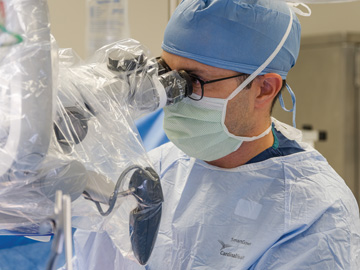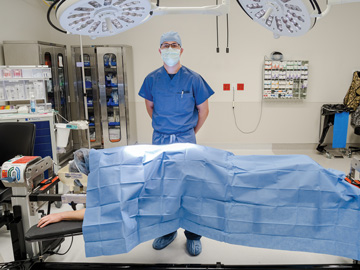• Expect non-instrumented cases. Most of the less-invasive outpatient spine operations Dr. Sielatycki performs are non-instrumented, an umbrella term for decompressions, procedures that relieve pressure caused by one or more
compressed nerve roots on the spinal column. “If a patient has a one- or two-level nerve root irritation, I can make a small incision and take the pressure off those nerves without having to implant anything,” he says.
Then there are conditions where the patient’s problem is more mechanical or structural. A patient might have a pinched nerve, but they could also be dealing with a slipped or shifting vertebra, which might require a spinal fusion. A spinal
fusion requires implanting screws and rods and reconstructing the spine in a way to relieve pressure on the nerves. Dr. Sielatycki says the downside of this procedure is that it can potentially accelerate breakdown of discs above or below
the site of the fusion.
• Invest accordingly. Performing complex fusion or disc procedures in the outpatient setting requires investing heavily in costly technology and equipment. “The standard or classic technique is using a fluoroscope or
a C-arm to take X-rays to perform minimally invasive placement of replacement discs or pedicle screws,” says Dr. Sielatycki. More recently, he says, newer technology such as navigational systems and robotic platforms allow for guided
placement of hardware. Combining the precision this navigation and robotic technology affords with newer pain control methods ultimately allows for more procedures to be done in surgery centers. “With some of the newer techniques, particularly
pain control methods, I can safely perform spinal fusions and disc replacements in an outpatient setting for more patients,” says Dr. Sielatycki. “A big part is the multimodal pain medications around the time of surgery, both before
and after. Local injections of pain medication in the tissues and around nerves can help patients be much more comfortable immediately after surgery and help them go home more quickly.”
Another crucial piece of equipment for outpatient spine is a good surgical microscope, a tool that Dr. Sielatycki relies on to tackle minimally invasive procedures such as a laminotomies, foraminotomies and diskectomies. “The surgical microscope
allows surgeons to make smaller incisions, but still see what we need to see,” he says.
Surgical microscopes have a big base that is firmly anchored to the floor and an arm with a viewing portal at the end of it. This arm is wrapped to keep it sterile and guided right over the patient by the surgeon. “I localize the surgical
site with X-rays and make a small incision,” says Dr. Sielatycki. “Then I use tubular retractor systems designed for minimally invasive techniques, which offer direct visualization of the operative field and minimize soft tissue
dissection and soft-tissue disruption.”
Placing sequentially larger tubes provides a viewing corridor from the incision all the way down to the spine for Dr. Sielatycki and then, with the microscope, he can look through the small corridors and magnify the view without needing to make
a big open incision. “The microscopes are lighted, which helps me see down into the small holes that I am working through,” he says. “You can get a nice bright light and a big view of what you’re working on, even though
it’s through a small incision.”
.svg?sfvrsn=be606e78_3)


.svg?sfvrsn=56b2f850_5)